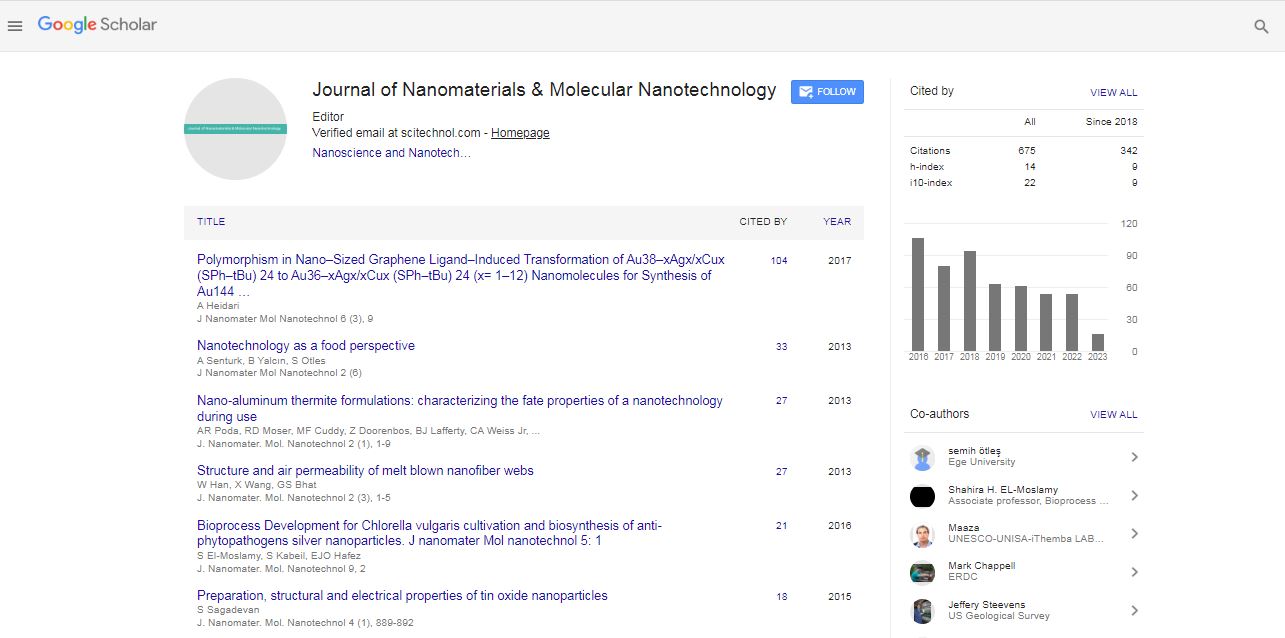Physiochemical analysis and tribological properties of composite coatings for bone regeneration
*Dagmara Slota, Bozena Tyliszczak, Agnieszka Sobczak-Kupiec, Wioletta Florkiewicz, Karina Pietak, Mateusz Dylag, Magdalena Glab,
Anna Drabczyk, Sonia Kudlacik Kramarczyk and Agnieszka Tomala
Cracow University of Technology, Poland
: J Nanomater Mol Nanotechnol
Abstract
A key feature of medical devices, including implants, is their multifunctionality to ensure effective and long-lasting functionality. One solution that can ensure this is coating of implants, thus creating specific layers of biomaterial. Implant coating is one of the strategies used to increase biocompatibility as well as provide additional functions without changing the base material. In the case of materials developed for bone regeneration, hydroxyapatite (HA) coating can be used to add the desired osteointegration feature. HA belongs to calcium phosphate ceramics, which are characterized by impressive biocompatibility and bioactivity. It also exhibits the ability to bond with natural tissue, which significantly eliminates the danger of implant loosening. Due to its structure, it can be modified with selected ions (e.g. Sr or Zn) to adduce additional antibacterial properties, or other active substances. Unfortunately, HA itself has low mechanical strength and high brittleness which limits its application. A solution to this problem may be to suspend HA in a polymer matrix to provide flexibility. The polymer phase is able to transfer stress while the resulting composite will not lose its bioactive properties given by the nature of HA. In the present study, innovative ceramic-polymer composite coatings based on polyvinylpyrrolidone (PVP) and polyethylene glycol (PEG) containing glutathione and collagen for bone tissue regeneration were developed. The materials were subjected to tribological and physicochemical analysis, as well as incubation studies to determine their properties and potential for use as a carrier for the active substance. Moreover, the developed biomaterials have great potential due to the high biological value of the components used in their synthesis, which promote osteogenesis. Acknowledgements: The „Multifunctional biologically active composites for applications in bone regenerative medicine” project is carried out within the TEAM-NET programme of the Foundation for Polish Science financed by the European Union under the European Regional Development Fund.
Research Publications:
1. SÅ?ota D, Florkiewicz W, Sobczak-Kupiec A (2020) Ceramic-polymer coatings on Ti-6Al-4V alloy modified with l-cysteine in biomedical applications. Materials Today Communications 25:1-8.
2. Arcos D, Vallet-Regi M (2020) Substituted hydroxyapatite coatings of bone implants. J. Mater. Chem. B 8:1781-1800.
3. Hou J, Wang Y, Xxue H, Dou Y (2018) Biomimetic Growth of Hydroxyapatite on Electrospun CA/ PVP Core–Shell Nano fiber Membranes. Polymers 10:1032.
4. Shen W, Liu W, Yang H, Zhang P, Xiao C, Che X (2018) A glutathione-responsive sulfur dioxide polymer prodrug as a nanocarrier for combating drug-resistance in cancer chemotherapy. Biomaterials178: 706-719. Ciobanu G, Harja M (2019) Cerium-doped hydroxyapatite/collagen coatings on titanium for bone implants. Ceramics International 45:2852-2857.
Biography
Dagmara SÅ?ota is a PhD student at the Doctoral School of the Cracow University of Technology, Faculty of Materials Engineering and Physics. In her research she concerns with bioactive ceramic-polymer composites and coatings as carriers of active substances, which may find application in regenerative medicine of the skeletal system and tissue engineering




